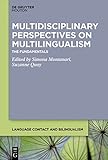Multidisciplinary Perspectives on Multilingualism : The Fundamentals / ed. by Simona Montanari, Suzanne Quay.
Material type: TextSeries: Language Contact and Bilingualism [LCB] ; 19Publisher: Berlin ; Boston : De Gruyter Mouton, [2019]Copyright date: ©2019Description: 1 online resource (VII, 422 p.)Content type:
TextSeries: Language Contact and Bilingualism [LCB] ; 19Publisher: Berlin ; Boston : De Gruyter Mouton, [2019]Copyright date: ©2019Description: 1 online resource (VII, 422 p.)Content type: - 9781501516504
- 9781501507908
- 9781501507984
- online - DeGruyter
- Issued also in print.
| Item type | Current library | Call number | URL | Status | Notes | Barcode | |
|---|---|---|---|---|---|---|---|
 eBook
eBook
|
Biblioteca "Angelicum" Pont. Univ. S.Tommaso d'Aquino Nuvola online | online - DeGruyter (Browse shelf(Opens below)) | Online access | Not for loan (Accesso limitato) | Accesso per gli utenti autorizzati / Access for authorized users | (dgr)9781501507984 |
Frontmatter -- Contents -- 1. Multilingualism from Multidisciplinary Perspectives: Introduction and Overview -- Part I: Societal Multilingualism: Historical, Political, Economic and Educational Forces in Different World Regions -- 2. Multilingualism, Language Varieties and Ideology in North Africa -- 3. Multilingualism in Southeast Asia: The Post-Colonial Language Stories of Hong Kong, Malaysia and Singapore -- 4. Multilingualism in Europe -- 5. Multilingualism in North America -- Part II: Language Use in Multilingual Communities -- 6. Diglossia in Multilingual Communities -- 7. Codeswitching in Multilingual Communities -- 8. Receptive Multilingualism -- 9. Multilingualism in Signing Communities -- Part III: Individual Multilingualism: From Development to Loss -- 10. Fostering Multilingualism in Childhood -- 11. Family Language Practices in Multilingual Transcultural Families -- 12. Multilingualism through Schooling -- 13. Language Attrition in Multilinguals -- Part IV: Differences between Bilingualism and Multilingualism -- 14. Facilitated Language Learning in Multilinguals -- 15. Cross-linguistic Interaction and Multilingual Awareness -- 16. Multilingualism and Cognitive Benefits in Aging -- 17. Multilingual Language Processing and the Multilingual Brain -- 18. Conclusion and Directions for Future Research -- Index of Key Words -- Index of Languages / Language Families -- Index of Countries and Continents
restricted access online access with authorization star
http://purl.org/coar/access_right/c_16ec
Multilingualism is a typical aspect of everyday life for most of the world’s population; it has existed since the beginning of humanity and among individuals of all backgrounds. Nonetheless, it has often been treated as a variant of bilingualism or as a phenomenon unique to individual areas of study. The purpose of this book is to review current knowledge about the acquisition, use and loss of multiple languages using a multidisciplinary perspective, highlighting the common themes and stimulating insights that can emerge when multilingualism is viewed from different but related areas of investigation. The chapters focus on research evidence, showing that multilingualism is a complex phenomenon that involves a myriad of linguistic and extra-linguistic forces and that should be studied in its own right as evidence of human potential and capacity for language. The book is primarily addressed to students and scholars interested in deepening their understanding of the different facets of multilingualism, including the individual and societal circumstances that contribute to it, the cognitive and neural mechanisms that make it possible, and the dynamics involved in the acquisition, use and loss of multiple languages.
Issued also in print.
Mode of access: Internet via World Wide Web.
In English.
Description based on online resource; title from PDF title page (publisher's Web site, viewed 25. Jun 2024)


